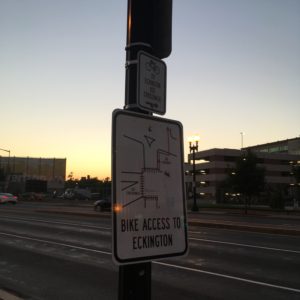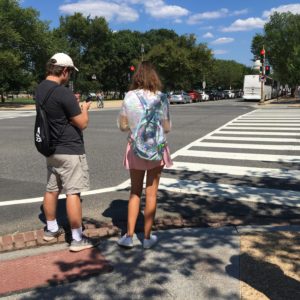 There are plenty of things to not like about Washington D.C. — the rats scurrying about in daylight, the climate, the density of politicians per square mile. But there is something there that Hartford could learn from: respect on the roadways.
There are plenty of things to not like about Washington D.C. — the rats scurrying about in daylight, the climate, the density of politicians per square mile. But there is something there that Hartford could learn from: respect on the roadways.
For perspective, while walking one block of Russ Street yesterday in Hartford, I witnessed more reckless and illegal driving than during 48 hours in the nation’s capital, where I walked approximately twenty miles. Standing at the corner of Buckingham and Main Streets — outside of rush hour — I heard three different drivers blast their horns in the course of one light cycle. Over two days in D.C., most of which were spent on foot, I heard a total of five drivers sound their horns. Twice in the same day, I saw drivers take left turns at red lights while pedestrians were crossing the intersections in Hartford; of the bad driving in D.C., I witnessed nothing that even approached this level of dangerous entitlement. That’s not to say that rude behavior never happens a few hundred miles south, but that the contrast is stark and undeniable.
If you decide to walk the two miles from the White House to the Folger Shakespeare Library, you can count on a portion of the route to be completely separated from cars, and the rest to include ample pedestrian phases at intersections. It is abnormal for a driver to blow a red light. Drivers don’t slowly inch up while you cross in front of them. Instead of anticipating chaos at every crossing, you learn to expect basic respect.
On one level, this experience can be explained by looking at the infrastructure, that is, the physical design and elements that create the space. There are bike lanes, not just sharrows. Crosswalks are well-marked and the pedestrian phase provides enough time so people need not sprint. There are none of those insulting beg buttons; people are automatically given a crossing cycle, just as cars get.
This has not always been the case. The District Department of Transportation (DDOT) adopted a Complete Streets policy in 2010 and National Capital Area Transportation did the same in 2012. Leading up to the former, D.C. updated its Bicycle Master Plan, Pedestrian Master Plan, Design and Engineering Manual, and Context Sensitive Design Manual. A major thoroughfare was even redesigned before the policy was in place; engineers went ahead and installed a protected two-way bike lane down the middle of Pennsylvania Avenue.
You get what you build for, and here, you get people walking and biking in greater numbers, with the pedestrian fatality rate dropping significantly. There are several bike-share companies competing in D.C., and bikes are everywhere. There are bike lanes, including those that are separated by actual barriers — because paint on its own does not protect. The result? Cyclists are not riding on sidewalks in large numbers, competing with pedestrians for space. Electric scooters are common, and despite what the fear merchants would like you to buy, people have not turned city streets and sidewalks into the Wild West.
 In places where the bike and pedestrian facilities are paint only, there is still a level of safety because in D.C. they bother to enforce laws.
In places where the bike and pedestrian facilities are paint only, there is still a level of safety because in D.C. they bother to enforce laws.
Automated traffic enforcement cameras issue around one million tickets in D.C. each year for red light, speed, stop sign, and oversized vehicle violations. The D.C. Metropolitan Police Department provides information about the location of these cameras, which correspond with high speed-crash related activity. A study reports that “vehicles exceeding the speed limit by more than 10 miles per hour decreased by 82 percent” in areas with traffic enforcement cameras. Because speed kills, this matters.
A nice side effect: actual revenue from fines. A small number of people issued tickets by traffic enforcement cameras bother to challenge them, and of those, 80% still have to pay the fine. This is all upsetting to those who like to get away with breaking the law, but for vulnerable users who are more likely to pay a physical price for drivers’ reckless behaviors, $150 for dashing through a red light seems like a fair penalty.
D.C. is not perfect. Some have criticized the placement of traffic cameras, suggesting that they have been disproportionately installed in predominately black neighborhoods. The Bicycle and Pedestrian Safety Amendment Act of 2016 was a mixed bag, with increased fines for repeat offenders removed. The stellar bike facilities are not found on every single street. Culturally, there are those who regard cyclists with disdain, expressing this in newspaper and blog articles — which is problematic, but less alarming than when a driver rolls down the window and orders you to get off the street before she hits you with her SUV¹. Despite only 40% of D.C. residents commuting by car, this mode still is granted the most space, either in terms of roadway or storage.
What D.C. lacks is inertia. That is to say, there is forward motion. Maybe they are motivated by courtesy — extending basic respect to other humans, regardless of how they get from place-to-place. Maybe they are motivated by the promise of ticket revenue, or simply seek to dodge lawsuits. Regardless, there have been sweeping, positive changes over the last decade.
If Hartford claims to want to compete, then Hartford needs to act like it. Making commutes less dangerous and stressful is a solid place to begin.
¹That actually happened. At night, when there was no other traffic, I was riding down a one-way street in Hartford, when a woman threatened to run me down. The speed limit on city streets is low and I had moved into the center temporarily to navigate around parked vehicles. On other occasions I have had drivers scream for me to get onto the sidewalk. If you have a few hours, we can talk about the amount of sexual harassment that I am subjected to on Hartford’s streets, whether I am walking or biking.
Greg Secord
Thanks as always for sharing your perspective
Cayla
This is so accurate. I try to ride my bike (in the street, not sidewalks) as much as possible through Hartford and am constantly honked at, yelled at, cat-called, and fearing for my safety because of reckless drivers. Thanks for shedding some light on a city that’s doing it right!
Kevin Sullivan
Thanks Kerri! Last year on vacation in DC I felt so much more relaxed walking and biking around than in Hartford. It didn’t sink in why until reading your article. Loved the fresh paint on crosswalks and the traffic enforcement cameras!